
Kastamonu Province is a province of Turkey, in the Black Sea region in the north of the country. It is surrounded by Sinop to the east, Bartın, Karabük to the west, Çankırı to the south, Çorum to the southeast and the Black Sea to the north. Its area is 13,064 km2, and its population is 378,115 (2022). The population density is 29 inhabitants per km2. The provincial capital Kastamonu has a population of 128,707 (2022).
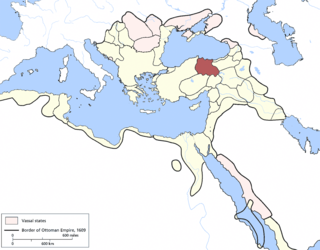
The Eyalet of Rûm, later named as the Eyalet of Sivas, was an eyalet of the Ottoman Empire in northern Anatolia, founded following Bayezid I's conquest of the area in the 1390s. The capital was the city of Amasya, which was then moved to Tokat and later to Sivas. Its reported area in the 19th century was 28,912 square miles (74,880 km2).

The Sultanate of Rûm was a culturally Turco-Persian Sunni Muslim state, established over conquered Byzantine territories and peoples (Rûm) of Anatolia by the Seljuk Turks following their entry into Anatolia after the Battle of Manzikert (1071). The name Rûm was a synonym for the medieval Eastern Roman Empire and its peoples, as it remains in modern Turkish. The name is derived from the Aramaic (rhπmÈ) and Parthian (frwm) names for ancient Rome, via the Greek Ῥωμαῖοι (Romaioi).

Van Province is a province and metropolitan municipality in the Eastern Anatolian region of Turkey, between Lake Van and the Iranian border. Its area is 20,921 km2, and its population is 1,128,749 (2022). Its adjacent provinces are Bitlis to the west, Siirt to the southwest, Şırnak and Hakkâri to the south, and Ağrı to the north. The capital of the province is the city of Van, with a population of 525,016 at the end of 2022. The second-largest city is Erciş, with 92,945 inhabitants at end 2022. The province is considered part of Western Armenia by Armenians and was part of ancient province of Vaspurakan. The region is considered to be the cradle of Armenian civilization. Before the Armenian genocide, Van Province was part of six Armenian vilayets. A majority of the province's modern day population is Kuresunni Azerbaijanis and Kurdish.

Anatolian beyliks were small principalities in Anatolia governed by beys, the first of which were founded at the end of the 11th century. A second and more extensive period of establishment took place as a result of the decline of the Seljuq Sultanate of Rûm in the latter half of the 13th century.
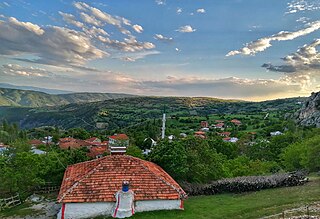
Tokat Province is a province in northern Turkey. Its area is 10,042 km2, and its population is 596,454 (2022). Its adjacent provinces are Amasya to the northwest, Yozgat to the southwest, Sivas to the southeast, and Ordu to the northeast. Its capital is Tokat, which lies inland of the middle Black Sea region, 422 kilometers from Ankara.

Tokat is a city of Turkey in the mid-Black Sea region of Anatolia. It is the seat of Tokat Province and Tokat District. Its population is 163,405 (2022). It is located at the confluence of the Tokat River with the Yeşilırmak.

The Germiyanids was a prominent Anatolian beylik established by the Oghuz Turkish tribes after the decline of Sultanate of Rûm. However, while the beylik was always mentioned as Turkoman or Oghuz Turkish, the population consisted of Turks and Yezidi Kurds, brought by the Seljuks from the east of Malatya to western Anatolia as militia guards against the threatening Turkish tribesmen.

Silivri is a municipality and district of Istanbul Province, Turkey. Its population is 217,163 (2022). It lies along the Sea of Marmara, outside the urban core of Istanbul, containing many holiday and weekend homes for residents of the city. The largest settlement in the district is also named Silivri.

Burdur is a city in southwestern Turkey. The seat of Burdur Province and of Burdur District, it is located on the shore of Lake Burdur. Its population is 95,436 (2021).

Niksar, historically known as Neocaesarea (Νεοκαισάρεια), is a city in Tokat Province, Turkey. It is the seat of Niksar District. Its population is 37,017 (2022). It was settled by many empires. Niksar is known as "Çukurova of North-Anatolia" due to its production of many kinds of fruits and vegetables. On May 2, 2018, Niksar was included in the World Heritage tentative list.

The Battle of Köse Dağ was fought between the Sultanate of Rum ruled by the Seljuq dynasty and the Mongol Empire on June 26, 1243, at the defile of Kösedağ, a location between Erzincan and Gümüşhane in modern northeastern Turkey. The Mongols achieved a decisive victory.
Comana Pontica, was an ancient city located in ancient Pontus, on the river Iris, at modern Gümenek near Tokat in Turkey.

Alā ad-Dīn Kayqubād ibn Kaykhusraw, also known as Kayqubad I, was the Seljuq Sultan of Rûm who reigned from 1220 to 1237. He expanded the borders of the sultanate at the expense of his neighbors, particularly the Mengujek Beylik and the Ayyubids, and established a Seljuq presence on the Mediterranean with his acquisition of the port of Kalon Oros, later renamed Ala'iyya in his honor. The sultan, sometimes styled Kayqubad the Great, is remembered today for his rich architectural legacy and the brilliant court culture that flourished under his reign.

Alanya Castle is a medieval castle in the southern Turkish city of Alanya.

Muʿīn al-Dīn Sulaymān Parwāna, simply known as Parwāna, was a Persian statesman, who was for a time a key player in Anatolian politics involving the Seljuk Sultanate of Rûm, the Mongol Ilkhanate and the Mamluks under Baybars.
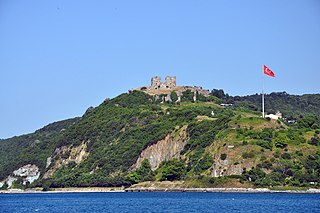
Yoros Castle is a ruined castle dating back to Byzantine times that stands above the confluence of the Bosphorus and the Black Sea, to the north of Joshua's Hill, in Beykoz district, Istanbul, Turkey. It is commonly referred to as the Genoese Castle, due to Genoa’s possession of it in the mid-15th century.
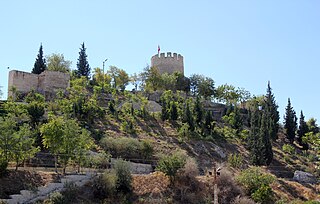
Mut Castle is a castle in Mut, Mersin Province, Turkey.

Anadolu Agency is a state-run news agency headquartered in Ankara, Turkey.
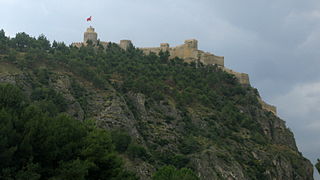
Boyabat Castle, is a castle in the town of Boyabat, Sinop Province, Turkey built by the Paphlagonians in antiquity and reconstructed under Roman, Byzantine, and Ottoman rule. The castle functions as a museum today.





















